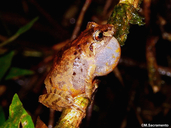|
Description
Ischnocnema holti is a robust frog, measuring up to 31.7 mm in SVL. Head is rounded, and wider than long. Rostral, rictal and loreal regions are slightly concave. Eyes are prominent and laterally directed. Nostrils are lateral, located near the tip of the snout. Horizontal pupil with translucent, unpigmented (except at the edge) palpebral membrane. Tympanum somewhat distinct with the annulus partially covered by skin. A pair of post-rictal conical tubercles is present posterior to the tympanum, less conspicuous in some individuals. Ovoid tongue has posterior notch. Discoidal fold present. Subarticular tubercles low and rounded. Thenar tubercle well developed and oval-shaped. Palmar tubercle less distinct and somewhat bifid. Supernumerary palmar tubercles are present but were varied in two specimens according to Targino and Carvalho-e-Silva (2008). Relative length of fingers: IV>V>III>II. Large and emarginate heart-shaped discs on fingertips. Nuptial excrescences are white and granular on the base of finger II. Relative length of toes: IV>V>III>II>I. Subarticular tubercles are rounded and well developed. Internal metatarsal tubercle oval and well-developed; external metatarsal tubercle is small and not as prominent. Supernumerary tubercle present below toe IV. Toe discs are well-developed except for that on toe I. Appendix calcaneus is small but size varies somewhat. Dorsal texture smooth or very finely granular, with small granulations on the sides. Perianal region and the back of thighs are extensively granulated. Venter is generally areolate but sometimes smooth, and gular region is smooth. Males have a single vocal sac.
Ischnocnema holti displays a wide variation in color. Dorsal color varies from dark brown to gray or green. Patterns vary from splotchy red, green, or brown marks to two longitudinal dark lines ranging from the eye to the posterior region. Supratympanic folds generally have a dark brown band. Some individuals exhibit two spots between the eyes. The belly may be entirely beige or brown; legs and arms typically have prominent stripes, but are less distinctive in some individuals. Tubercles on the hands and feet can be blackened or clear. The hidden area of flanks, thighs, and tibiae often have a vivid red or orange color. The iris is green with dark spots. Distribution and Habitat
Country distribution from AmphibiaWeb's database: Brazil
Ischnocnema holti occurs in Itatiaia National Park in Brazil at elevations between 2000 and 2400 meters asl. It is generally arboreal and has been found mostly in closed forest formations, although it has also been observed in ravines, and in lichens, poáceas, and moss. Life History, Abundance, Activity, and Special Behaviors
Peak vocalization occurs at twilight, although calls can be heard throughout the entire night and even during the day. Calling locations include the leaves of shrubs (up to 4 m above ground) that are supported either horizontally or vertically, and forested ravines. This species has also been spotted calling from moss along the roadside even on rainy, cold days. However, when temperatures fall below 0°C and there is ice on the ground, which typically occurs between June and July, vocalization does not occur.
Specimens collected in March were much smaller in size, which may indicate that reproduction occurs during the summer. Female ovaries are large but carry few eggs (approximately 15). Individual eggs measure between 2 and 3 mm in diameter and are wrapped in a thin, transparent membrane. Since this species is not associated with a water source, it is likely to have direct development, as do other species in the genus Ischnocnema. Trends and Threats
It is found within a protected area, Itatiaia National Park.
References
Targino, M. and Carvalho-e-Silva, S. P. de (2008). ''Redescrição de Ischnocnema holti (Amphibia: Anura: Brachycephalidae).'' Revista Brasileira de Zoologia, 25(4), 716-723.
Originally submitted by: Catherine Aguilar (first posted 2009-03-17)
Edited by: Kellie Whittaker (2009-05-01)Species Account Citation: AmphibiaWeb 2009 Ischnocnema holti <https://amphibiaweb.org/species/2968> University of California, Berkeley, CA, USA. Accessed Jun 6, 2025.
Feedback or comments about this page.
Citation: AmphibiaWeb. 2025. <https://amphibiaweb.org> University of California, Berkeley, CA, USA. Accessed 6 Jun 2025.
AmphibiaWeb's policy on data use.
|
